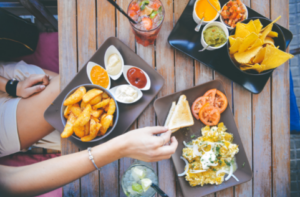From when we’re young, we begin to pick up on rules: Don’t touch the stove, look both ways when crossing the street, hands at 10 and 2 when driving. Some rules are designed to keep us safe and healthy while others can sometimes do more harm than good. That's right - we're talking food rules.
In our work with clients, we see a lot of food rules come up that significantly impact their relationship with food itself. Creating rules around what we can or can’t eat, when we can eat, or how often to eat can ultimately chip away at food freedom. The more food rules that are added to the list, the more difficult it can be to tune into your own body cues and eat intuitively.
If you are on a journey to Intuitive Eating an important step along the way is to untangle yourself from those food rules. This sounds like a daunting task but, rest assured, we are here to walk you through it. Before we can get to pushing back against these rules, we have to start with recognizing they exist. Let’s dive in!

What is a food rule?
Food rules are ideas that you may have about foods that are based on external factors, rather than your internal cues. More often than not, there is a “should” somewhere in it, too. What we mean is that the rule does not always align with what you want, but with what you feel you “should” be doing.
Here are some examples:
- “I shouldn’t eat past 6 pm”
- “I can only have one dessert per week”
- “I shouldn’t have a carbohydrate with lunch”
- “I should wait to eat lunch until 12:00pm”

In the Intuitive Eating book, we hear authors Tribole and Resch talk about the “Food Police.” This is the voice in our heads that is enforcing the food rules and policing your decisions. As mentioned above, consistently giving into the Food Police can ultimately create a sense of body disconnection and negatively impact your relationship with food.
Are you feeling so over always letting the Food Police drive the ship in your food decisions? Us too. Let’s take a look at how to quiet the Food Police for good.
How to recognize food rules
1. It brings feelings of guilt or shame
Where food rules go, negative feelings often follow. Just like when you were a kid and you broke a rule, you probably felt some feelings of guilt afterwards. It is the same with breaking food rules! When you break a food rule, no matter how arbitrary it may be, it can feel like you’ve done something wrong, or like you’ve failed.
Therefore, an easy way to spot a food rule is if you are feeling some negative emotions after eating. When this happens, take a step back and ask yourself “what about that eating experience is making me feel like I did something wrong?”
From there, you should be able to pinpoint a rule or expectation that you had going into the meal or snack.

2. It started from a diet
Diets are famous for making up their own rules for how you should eat. Depending on the diet, maybe carbohydrates were demonized. Or, maybe it was a sin to eat anything past 6pm. These rules are put in place by a diet or program to make its participants feel as though there is a right way to eat, and all you have to do to reach your goals is x, y, and z.
The issue is that even after you’ve stopped the diet (because let’s face it, they are unsustainable 99% of the time), those food rules remain! In fact, they may become so habitual that you don’t even notice they’re there anymore. That’s why we challenge you to take a critical look at any past dieting experiences you have had, and see what food rules may be lingering in your day-to-day life.
3. There is no fact to support it
Here’s the thing - food rules are often masked as “the answer” to all of your weight loss prayers. However, they are almost never based in fact. So, we challenge you to seek out the facts behind the rules. Or, are there any facts at all?
If you’re not sure where to look, start by talking to your dietitian! They are pretty good at spotting those food rules, and can offer the facts that you need to quiet the Food Police once and for all.

How to break food rules
1. Re-frame with positive thoughts
When that nasty voice pops into your head saying “you shouldn’t have eaten that” or “it’s not time to eat yet,” instead of accepting the guilt that comes along with it, try to re-frame those thoughts.
Try this exercise: When a negative thought pops into your head, write it down. Then, write three positive thoughts underneath it. Even if you are not feeling 100% connected to that positive thought, write it down.
Then, next time that negative thought creeps in, take a look at the positive thoughts that you wrote down. Soon enough, this will become more and more natural.
2. Break the rule
Okay, okay - easier said than done, we know. However, engaging in opposite action (or doing the opposite of what the Food Police is telling you to do) of your food rules is a crucial part of quieting the Food Police once and for all.
Curious on how to do this? Start by taking a look at your food rules, and choose one to break at a time. Then, break it again. And again. The more that you break it, the more natural it will become.
As you do so, observe how it feels to break that rule. Did anything bad happen? Was it satisfying to eat in a different way? Stay curious as you continue to challenge these rules, and remember to give yourself grace in the process.
3. Talk it out
We understand that this can be a lot to navigate on your own. It can be helpful to talk it through with a dietitian, or with someone navigating a similar challenge.
Throughout our work with 1:1 clients we have seen so many brave clients work through the food rules that have become so engrained in their minds. We know that this is no easy feat and it is possible. The good news is we (and your community) are here to support your every step of the way. Now, let’s break some rules!
Comments Off on How to Recognize and Break Food Rules